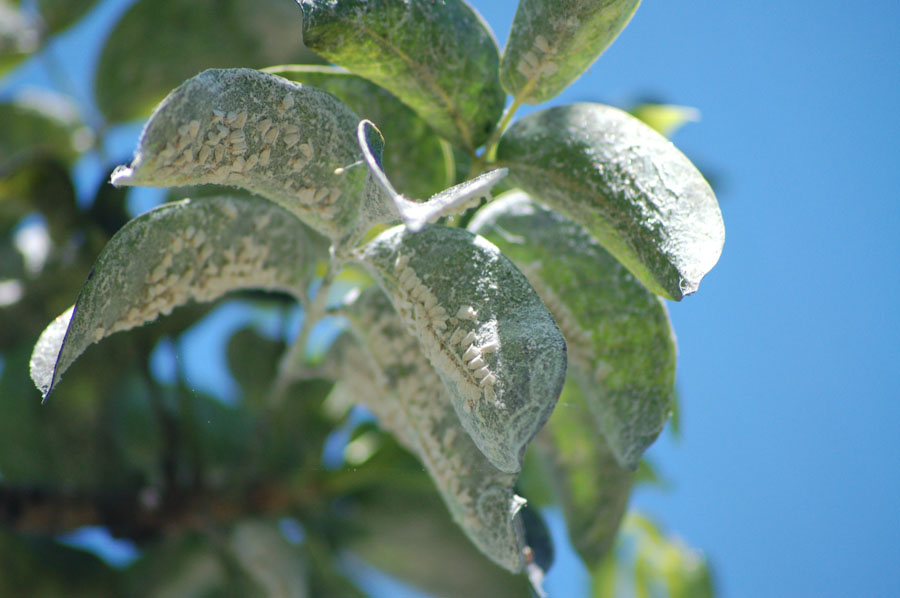Sooty Mold Takes Hold on South Florida

As Published in the Miami Herald
There is a black plague spreading across South Florida. Plant leaves, automobiles, pool decks, sidewalks and anything else that has the unfortunate lot to be under infected trees are all turning sticky and black. The cause of this black mess is a fungus called sooty mold.
Sooty mold can’t be controlled through simple fungicide spraying, because its real cause is insects. When insects such as aphids, scale or whitefly feed on plants, they drip a sweet byproduct of their feeding known as honeydew. The sticky honeydew falls down on whatever is below and the sooty mold soon begins to grow on the honeydew, turning cars, decks and plants as black as night.
For many homeowners, sooty mold is the first sign that something is wrong, and they often try to treat the it without treating the pest that is causing it. Often, worried homeowners can’t even see the pest. Insects such as scale are very small and blend in well with the plant’s stems or leaves.
Sooty mold has been around for many years, but it has come to prominence during the last three years with the emergence of new pests including the Croton Scale, the Nesting Whitefly and the Rugose Whitefly.
 |
| Sooty mold on gumbo limbo leaves, caused by the Croton Scale and Rugose Whitefly. |
The Croton Scale is a large scale that attacks many plants, including firebush, gumbo limbos and crotons and it is a major contributor to sooty mold.
The Nesting Whitefly is a new pest currently attacking Ficus benjamina, the ubiquitous ficus hedge plant that was already waning because of attacks from the Ficus Whitefly. How can you tell if your ficus has Nesting Whitefly? The Ficus Whitefly causes defoliation of Ficus benjamina, but does not drip honeydew when it feeds. So if you have sooty mold on your ficus hedge, you have the Nesting Whitefly.
The Rugose Whitefly is probably the biggest contributor to the proliferation of sooty mold, as this pest attacks a wide variety of palms, trees and shrubs. This whitefly is larger than typical ones and unlike most, it does not fly when disturbed. It can also be identified by the spiral pattern in which it lays its eggs.
 |
| Sooty mold on aroids under a tree being attacked by insects. |
So how do you stop sooty mold? If you control the pest feeding on your plants, you will control sooty mold. The good news is that there are a lot of natural predators that help to control many of the pests associated with sooty mold. Ladybugs, parasitic wasps, jumping spiders, assassin bugs and a host of other predators are constantly working to keep nature’s balance and to keep pests from getting out of hand.
You have a much better chance of attracting natural predators to your garden if you do not spray pesticides and you have a variety of plants. If you spot a pest, your first instinct might be to poison it, but often predators are already there beginning to control the pests. Pesticides often do more damage than good because pests reproduce at much higher rates than predators and will therefore rebound much more quickly if both types of insects are exposed to pesticides.
 |
| The Rugose Whitefly is larger than most whiteflies and lays its eggs in a spiral pattern. |
If your car or your deck is steadily turning black, you may not be able to wait for predator insects to work their magic. You can start by trimming some of the infected areas. That will help remove a large portion of the pests and begin to slow them. You can also try spraying the plants with a strong spray of water to further remove pests. Insecticidal soap or oils can also be used to control pests. These should be used in the early morning or late afternoon when the sun is not as bright, since soaps and oils can burn your plants if applied in full sun.
Remember, controlling the fungus sooty mold is not as easy as spraying a fungicide and walking away. Sooty mold is another cog in the wheel that is nature, and to get it under control you must control its cause. Your best bet is to have a bit of patience, a garden that boasts a wide variety of plants and to stay away from pesticides.
